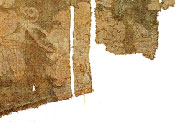 |
 |
|||||||||||||||||
 |
||||||||||||||||||
 |
||||||||||||||||||
| Classified Glossary | ||||||||||||||||||
 |
||||||||||||||||||
 |
||||||||||||||||||
| 1.warp-faced compound weave (jingchongzuzhi), is the classic polychrome, patterned silk structure used in Chinese textiles. The term jin-silk suggests this type and could be divided into: a. warp-faced compound tabby (pingwenjingchong), first appeared in the Western Zhou, popular during the Warring States and Qin, Han period; b. looped warp-faced compound tabby (rongquanjingchong), first appeared around the time of the Western Han period; c. warp-faced compound twill (xiewenjingchong) became the most popular weave structure during the Sui and Tang dynasties, replacing the warp-faced compound tabby. 2. weft-faced compound weave (weichongzuzhi), is a product influenced by weaving techniques which was introduced from the West during the period between the Northern dynasty to Tang dynasty, may be further divided into: a. weft-faced compound tabby (pingwenweijin), also called taquete, originated in western or central Asia and came to China in the 3rd-5th century; b. weft-faced compound twill (xiewenweijin), also called samite, originated in western or central Asia and appeared in China during the Tang dynasty; c. compound twill weft-faced on both sides (banmingxingxiewenweijin) appeared in the late Tang, popular during Liao, could be called Liao samite (liaoshiweijin); d. compound satin weft-faced on both sides (banmingxing duanwenweijin), appeared in the Liao dynasty, could also be called satin samite (duanwenweijin). e. brocaded compound twill/ satin (zhuanghuaweijin) from the Liao dynasty. f. compound satin with floats (fuwenweijin), from the Liao dynasty. |
||||||||||||||||||
| THE BOOK | ||||||||||||||||||
| AUTHOR | ||||||||||||||||||
| CONTENTS | ||||||||||||||||||
| ORDER | ||||||||||||||||||
| CONTACT | ||||||||||||||||||
| LINKS | ||||||||||||||||||